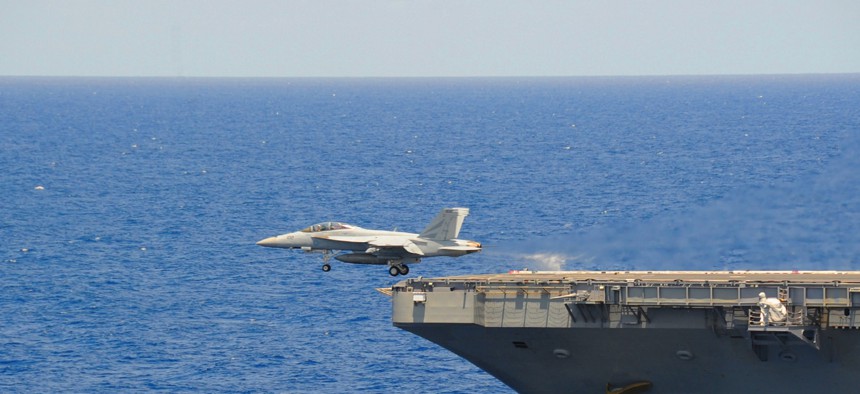
An F/A-18 Super Hornet assigned to the Black Knights of Fighter Attack Squadron (VFA) 154 is launched from the flight deck of the aircraft carrier USS Ronald Reagan (CVN 76). U.S. Navy photo by Lt. j.g. Joseph Pfaff
The US Isn’t Challenging China’s Claims in the South China Sea — Yet
Inaccurate media portrayals of the Navy’s flights over Chinese islands are needlessly turning up the heat in a disputed region.
The US Navy’s plans to use military ships and aircraft to challenge China’s aggressive land reclamation activities in the South China Sea have led some to claim that the US is challenging China’s “sovereignty” or territorial claims. But while there is a real dispute brewing between the US and China that could indeed escalate into a sovereignty fight, the truth is we’re not there yet.
The US Navy is simply asserting its rights to freedom of navigation under international law. Understanding this could help us defuse the growing tensions between the US and China in the region.
According to CNN, for example, the Pentagon is “carrying out the surveillance flights in order to make clear the US does not recognize China’s territorial claims.” In this story, the US Navy flies over the Chinese islands in order to challenge or reject China’s territorial claims. But in fact, the US Navy has tried to make it clear that they are merely conducting freedom of navigation operations, commonly used to assert international law rights of navigation against numerous countries around the world. It is NOT, as the CNN and other reports suggest, a challenge to China’s territorial claims.
What is a freedom of navigation operation?
“Freedom of Navigation” operations involve sending US Navy warships into both the 200 nautical mile (nm) Exclusive Economic Zone and the 12 nm territorial seas recognized under the UN Convention on the Law of the Sea (UNCLOS).
The US Navy has already been conducting “freedom of navigation” operations for decades to enforce these views of international law. It even has a “Freedom of Navigation” website making public where it has been operating.
In the view of the United States, military warships and aircraft are free to conduct surveillance operations (e.g. spying) in any country’s 200 nm EEZ, and surface warships (but not military aircraft or submarines) have the right to “innocent passage” through a country’s 12 nm territorial waters.
The point of these operations is to publicly challenge any country which seems to be asserting unjustified legal rights under UNCLOS. China has a longstanding disagreement with this US interpretation of the law of the sea. So they always make protests, and China has sometimes sent its fighter jets out to harass or challenge US spy aircraft.
But the bottom line: freedom of navigation operations are not challenges to “territorial claims” or “sovereignty”; US Navy operations already assume that the other nation has “sovereignty” over the relevant coastline or island. So the US Navy operations near China’s artificial islands can assume that China has sovereignty but still demand the standard transit rights.
What would constitute a territorial challenge?
Of course, it is worth noting that the US could soon escalate the dispute with China.
The US might take the view, for example, that China is building artificial islands on top of reefs or submerged features which do not entitle China to any legal rights at all (See UNCLOS, Art.60(8): “Artificial islands, installations and structures do not possess the status of islands. They have no territorial sea of their own, and their presence does not affect the delimitation of the territorial sea, the exclusive economic zone or the continental shelf.”)
If so, then the US would fly within 12 nm miles or even directly over the artificial islands. Such operations would effectively be a direct challenge to China’s territorial claims, but they haven’t happened yet
“Challenging legal rights under UNCLOS” doesn’t make for very sexy headlines. But it is worth parsing media reports about US Navy activities in the South China Sea carefully, to clarify just how close the US Navy flies or sails to China’s reclaimed islands. For now, the US hasn’t challenged China’s territorial claims yet, and to claim that it has is only adding fuel to an already tense moment.



